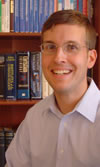The Uncanny Nature of Love
by Michael Osborne
Parents expecting their second child frequently wonder, Will I ever be able to love the second as much as the first? Not that the first is inherently more lovable. It’s that the first got exclusive love and attention for months or years before the second came along, and the second is born into a world in which he or she shares the parents’ attentions with the  firstborn. And certainly time and resources are limited, and time and resources must be shared. However, love itself does not follow that math.
firstborn. And certainly time and resources are limited, and time and resources must be shared. However, love itself does not follow that math.
Love is rooted in the eternal God who is love (1 John 4:8). And love can grow with its object, or objects. J.I. Packer described God’s love as His binding up His happiness with ours. Romans 12:15 instructs us, “Rejoice with them that do rejoice, and weep with them that weep” (KJV). That would be love. First Corinthians says that love “rejoiceth not in iniquity, but rejoiceth in the truth” (13:6). The remainder of the chapter describes love as humble, selfless, and thoughtful toward another person’s interests. Love is happy at someone else’s good (John, who had “no greater joy” than to see his children “walk in truth”—3 John 4) and distressed at someone else’s distress (Epaphroditus, who when sick was actually distressed at other people’s distress over his sickness—Phil. 2:26!).
If love is this affection toward another, this orientation toward another’s wellbeing, then of course it has no trouble keeping up with additions to the family or to the congregation. If anything, these additions help love to grow. Love, by entering into another’s interests, by admiring the qualities of another, can stretch. Watch an octogenarian couple walk hand in hand. Their mutual knowledge has made their love unshakably strong; no newlyweds can boast of this love, even if their love is apparently full of spark. A father who has invested time, energy, play, instruction, comfort, encouragement, discipline, and tears into the life of his child loves that child the more for it, not less. He appears to have been spending, but really in another sense he is gaining. Love is more like muscles than like money; the cash supply dwindles with use, but muscles get stronger.
Love doesn’t follow the math of money or commodity. Then again, God has set up the human race itself to follow a strange math. A man loves a woman, and together they have a child. In what other circumstance does one plus one equal three? In God’s world, one plus one can equal three, four, five, more. God breathed into Adam’s nostrils, and that breath has kept us all going thousands of years; and every year, world population statistics tell us that still more people are breathing. And somehow each new person isn’t taking an increasingly infinitesimal fraction of God’s first breath with him. Instead it’s multiplying toward infinity. (For mathematics aficionados: the asymptote is slanting up, not down.)
So parents’ concerns about their ability to love their second as much as the first are unfounded or poorly phrased. But it is true that the resources for expressing that love are limited, divisible.
In this respect, God follows a math that mankind never will be able to follow. God’s resources to express His love are as boundless as the love itself. He matches His omnibenevolence with omnipotence, omniscience, and omnipresence. He can supply all needs, know all needs, and be ever present to supply them for His people. God’s resources are bottomless. Santa’s bottomless bag is a myth that only hints at God’s resources. The bottomless cup of coffee at the local diner is a nice gesture that’s never really been put to the test. But God’s love and boundless resources are real, and He has undertaken to demonstrate them to our finite minds.
God’s love would be magnificent if poured out on one or two creatures alone, but He has chosen to show His love by redeeming a host of sinners. And it is in this context of redeemed sinners that we begin to get an inkling of what that love is like. The love is so great, so multifaceted, so inexhaustible that we actually need to “compare notes” with everyone else in that company before we can really comprehend what God wants to demonstrate.
“For this cause I bow my knees unto the Father of our Lord Jesus Christ, of whom the whole family in heaven and earth is named, that he would grant you, according to the riches of his glory, to be strengthened with might by his Spirit in the inner man; that Christ may dwell in your hearts by faith; that ye, being rooted and grounded in love, may be able to comprehend with all saints what is the breadth, and length, and depth, and height; and to know the love of Christ, which passeth knowledge, that ye might be filled with all the fulness of God” (Eph. 3:14–19, emphasis added).
 Michael Osborne received a B.A. in Bible and an M.A. in Church History from Bob Jones University (Greenville, SC). He co-authored the teacher’s editions of two BJU Press high school Bible comparative religions textbooks What Is Truth? and Who Is This Jesus?; and contributed essays to the appendix of The Dark Side of the Internet. He lives with his wife, Becky, and his daughters, Felicity and Elinor, in Omaha, Nebraska, where they are active members at Good Shepherd Baptist Church. Mike plans to pursue a further degree in apologetics. Michael Osborne received a B.A. in Bible and an M.A. in Church History from Bob Jones University (Greenville, SC). He co-authored the teacher’s editions of two BJU Press high school Bible comparative religions textbooks What Is Truth? and Who Is This Jesus?; and contributed essays to the appendix of The Dark Side of the Internet. He lives with his wife, Becky, and his daughters, Felicity and Elinor, in Omaha, Nebraska, where they are active members at Good Shepherd Baptist Church. Mike plans to pursue a further degree in apologetics. |
- 1 view


Discussion